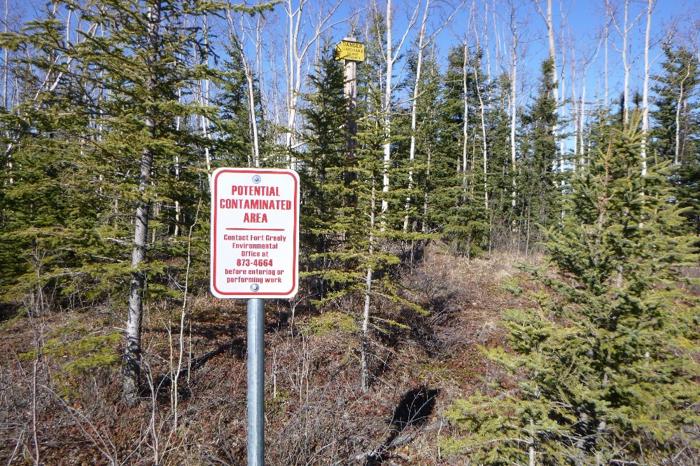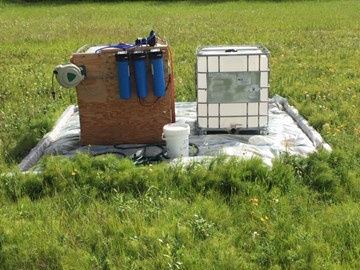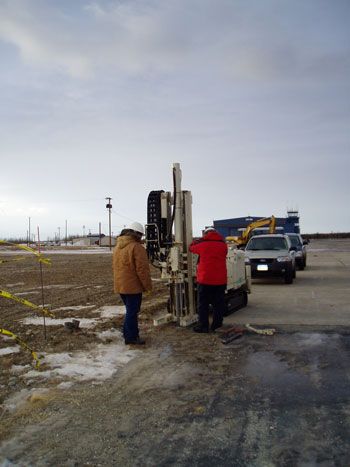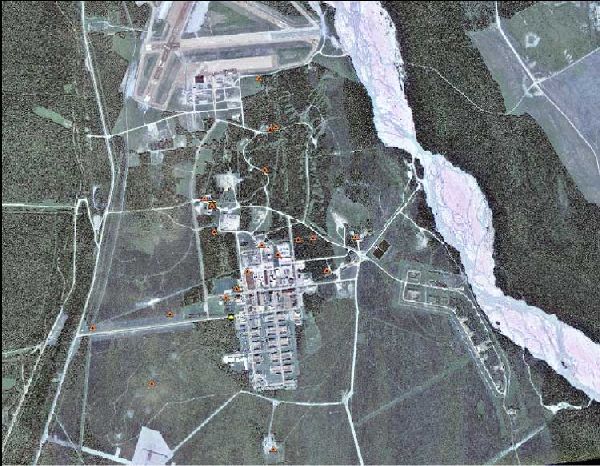Fort Greely, U.S. Army Garrison Alaska
- View detailed information from the database on this site.
- Database Name: Fort Greely
- Status: Active
- Location: Delta Junction
- Latitude: 63.973772
- Longitude: -145.716144
This site has a Restoration Advisory Board, which involves the community.
DEC Contaminated Sites contact: Carly Jensen, Project Manager (Wasilla), 907-269-3077
Fort Greely contact: Ron Crofford, Fort Greely Environmental Division Chief, 907-873-3105
Fort Greely contact: Justin Hogrefe, Project Manager, Phone: 907-873-4664
U.S. Army Environmental Command (AEC) contact: Sam Klein, Phone: 520-674-2304
- Click on photos or maps for larger versions.
- Contacts updated: 2/16/2023
- Summary updated: 2/16/2023
Site Narrative
Background
Fort Greely, Alaska (FGA) is located approximately 100 miles southeast of Fairbanks, Alaska, and approximately 5 miles south of the City of Delta Junction on the Richardson Highway in Interior Alaska. The installation is bordered by Jarvis Creek to the east and the Delta River to the west.
FGA was established in 1942 as an Army Air Corp base that served as a staging area for aircraft being ferried over to Russia during World War II. Fort Greely was deactivated in 1945 but was reactivated in 1947 as an army post for United States (U.S.) Army Troops. In 1949, the Army established a cold regions testing center to test how all types of Army equipment performed in extremely cold regions. A nuclear reactor was built in the early 1960s and it provided the post’s power until 1972. The post was designated as Fort Greely in 1955.
In 1995, FGA was selected for the Base Realignment and Closure (BRAC) Program, which began the partial closure of the base. The post was broken into parcels (each assigned a BRAC number). The BRAC closure process was stopped at FGA in 2002 when the Missile Defense Agency selected FGA as one of the locations to deploy a ground-based missile defense system. The U.S. Army Space and Missile Defense Command (USASMDC) put FGA back up as an active installation and continued with the installation restoration process. FGA’s training ranges were transferred to Fort Wainwright as part of the BRAC realignment and FGA is now approximately 7,000 acres in size (previously 640,000 acres).
In June of 2003, USASMDC organized a meeting with past and current environmental personnel involved with FGA to list all sites on FGA where there was suspected or confirmed contamination. The list of 132 sites originated from examination of all BRAC parcels, the U.S. Environmental Protection Agency’s (USEPA) Solid Waste Management Units (SWMU) list, the Alaska Department of Environmental Conservation (DEC) Contaminated Sites database, and the Army Environmental Database.
On August 30, 2018, the management of Fort Greely was placed under the leadership of a Fort Wainwright-based command. With this change, Fort Wainwright-based command will be referred to as U.S. Army Garrison Alaska (USAG) going forward. Fort Greely will continue to be referred to as U.S. Army Garrison Greely.

Photo shows a sign warning Fort Greely personnel about potential contamination. [Photo by Erica Blake (Alaska Department of Environmental Conservation), April 2019]
Public Health and Environmental Concerns
The contaminants at FGA mainly consist of fuel or fuel byproducts (typically from fuel spills). Other contaminants of concern (COCs) include chlorinated solvents, pesticides, dioxins, and metals. Soil sampling has revealed pesticide, dioxin, and metals contamination that has resulted from improper storage and disposal practices, burning of solid wastes, and other historical practices.
People may come in direct contact with contaminated soil or groundwater. Depending on site location, there is also potential for vapor intrusion.
For information on site-specific contaminants, visit the DEC CS Contaminated Sites Database, and using the Site Name search box, type in ‘Fort Greely.’
Per- and Polyfluoroalkyl Substances (PFAS)
In 2016, two PFAS compounds, perfluorooctane sulfonate (PFOS) and perfluorooctanoic acid (PFOA) were sampled. PFOS and PFOA were detected below the DEC project action level of 0.4 micrograms per liter (µg/L) but above the EPA Health Advisory level of 0.07 µg/L at the former Fire Training Pits which are upgradient from Jarvis Creek.

During long-term monitoring activities on Fort Greely, purgewater from groundwater sampling activities is generated. Due to the purgewater potentially containing contaminants of concern, the water is run through a granular activated carbon (GAC) system prior to discharging back to the site. [Photo by Leopold Palmer (USAG Fort Greely) June 2021]
A preliminary assessment (PA) and site investigation (SI) was conducted at FGA. The PA site visit occurred in 2018 and during that time personnel around FGA were interviewed to determine where known AFFF source areas were. In 2020 and 2021 SI fieldwork occurred at 21 areas of potential interest (AOPIs). The U.S. Army focused the investigation on three PFAS: PFOS, PFOA and perfluorobutanesulfonic acid (PFBS). The Final Preliminary Assessment and Site Inspection of Per-and Polyfluoroalkyl Substances Fort Greely, Alaska (dated June 2022) was finalized in 2022. The SI identified areas with PFAS contamination in the soil and groundwater which will require further investigation at the remedial investigation (RI) phase.
Scoping for the PFAS RI is expected to occur in 2023, and fieldwork for the RI phase to be conducted fall 2024 or 2025.
For more information on FGA sites with PFAS, see links below:
- DEC Database Fort Greely Former Fire Training Area BRAC 85N
- DEC Database Fort Greely Former Fire Training Area BRAC 85S
- DEC Database Fort Greely Former Fire Training Area BRAC 133
- DEC Per- and Polyfluoroalkyl Substances (PFAS) Webpage

View facing south of monitoring wells with bollards around them for protection. [Photo by Erica Blake (DEC) in June 2022
For more information regarding the PFAS investigation, see link below:
SM-1A Nuclear Reactor Decommissioning
DEC has been working with the U.S. Army Corp of Engineers (USACE) Baltimore District staff regarding the upcoming decommissioning of the nuclear reactor on Fort Greely. If there are questions about this project, please reach out to USACE.
Current Status
The USAG will continue with environmental investigations to cleanup Fort Greely. A Restoration Advisory Board (RAB) has been established for Fort Greely. RAB meetings typically occur in the spring (last week of April or early May), on a yearly basis. During these RAB meetings, the U.S. Army presents information on current cleanup status, and what is planned for future cleanup efforts. These meetings are also intended for the public to attend and raise any questions or concerns.
More Information
Documents
- Environmental Sites Final Draft Decision Document June 2005 (PDF)
- Record of Decision Nine Installation Restoration Program Sites September 2009 (PDF)
Links
U.S Army Garrison Alaska: Fort Greely.
Legend
| Image | Meaning |
|---|---|
| Contaminated Sites | |
| Leaking Underground Tanks |


